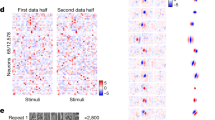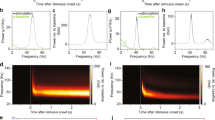Abstract
Membrane potentials of cortical neurons fluctuate between a hyperpolarized (‘down’) state and a depolarized (‘up’) state which may be separated by up to 30 mV, reflecting rapid but infrequent transitions between two patterns of synaptic input. Here we show that such fluctuations may contribute to representation of visual stimuli by cortical cells. In complex cells of anesthetized cats, where such fluctuations are most prominent, prolonged visual stimulation increased the probability of the up state. This probability increase was related to stimulus strength: its dependence on stimulus orientation and contrast matched each cell's averaged membrane potential. Thus large fluctuations in membrane potential are not simply noise on which visual responses are superimposed, but may provide a substrate for encoding sensory information.
This is a preview of subscription content, access via your institution
Access options
Subscribe to this journal
Receive 12 print issues and online access
$209.00 per year
only $17.42 per issue
Buy this article
- Purchase on Springer Link
- Instant access to full article PDF
Prices may be subject to local taxes which are calculated during checkout





Similar content being viewed by others
References
Carandini, M. & Ferster, D. A tonic hyperpolarization underlying contrast adaptation in cat visual cortex. Science 276, 949–952 (1997).
Lampl, I., Reichova, I. & Ferster, D. Synchronous membrane potential fluctuations in neurons of the cat visual cortex. Neuron 22, 361–374 (1999).
Wilson, C. J. & Groves, P. M. Spontaneous firing patterns of identified spiny neurons in the rat neostriatum. Brain Res. 220, 67–80 (1981).
Wilson, C. J. The generation of natural firing patterns in neostriatal neurons. Prog. Brain Res. 99, 277–297 (1993).
Wilson, C. J. & Kawaguchi, Y. The origins of two-state spontaneous membrane potential fluctuations of neostriatal spiny neurons. J. Neurosci. 16, 2397–2410 (1996).
Stern, E. A., Kincaid, A. E. & Wilson, C. J. Spontaneous subthreshold membrane potential fluctuations and action potential variability of rat corticostriatal and striatal neurons in vivo. J. Neurophysiol. 77, 1697–1715 (1997).
Plenz, D. & Kitai, S. T. Up and down states in striatal medium spiny neurons simultaneously recorded with spontaneous activity in fast-spiking interneurons studied in cortex-striatum-substantia nigra organotypic cultures. J. Neurosci. 18, 266–283 (1998).
Stern, E. A., Jaeger, D. & Wilson, C. J. Membrane potential synchrony of simultaneously recorded striatal spiny neurons in vivo. Nature 394, 475–478 (1998).
Steriade, M., Contreras, D., Curro Dossi, R. & Nunez, A. The slow (<1 Hz) oscillation in reticular thalamic and thalamocortical neurons: scenario of sleep rhythm generation in interacting thalamic and neocortical networks. J. Neurosci. 13, 3284–3299 (1993).
Metherate, R. & Ashe, J. H. Ionic flux contributions to neocortical slow waves and nucleus basalis-mediated activation: whole-cell recordings in vivo. J. Neurosci. 13, 5312–5323 (1993).
Arieli, A., Sterkin, A., Grinvald, A. & Aertsen, A. Dynamics of ongoing activity: explanation of the large variability in evoked cortical responses. Science 273, 1868–1871 (1996).
Stevens, C. F. & Zador, A. M. Input synchrony and the irregular firing of cortical neurons. Nat. Neurosci. 1, 210–217 (1998).
Movshon, J. A., Thompson, I. D. & Tolhurst, D. J. Receptive field organization of complex cells in the cat's striate cortex. J. Physiol. (Lond.) 283, 79–99 (1978).
Skottun, B. C. et al. Classifying simple and complex cells on the basis of response modulation. Vision Res. 31, 1079–1086 (1991).
Jagadeesh, B., Gray, C. M. & Ferster, D. Visually evoked oscillations of membrane potential in cells of cat visual cortex. Science 257, 552–554 (1992).
Gustafsson, B. & McCrea, D. Influence of stretch-evoked synaptic potentials on firing probability of cat spinal motoneurones. J. Physiol. (Lond.) 347, 431–451 (1984).
Mainen, Z. F. & Sejnowski, T. J. Reliability of spike timing in neocortical neurons. Science 268, 1503–1506 (1995).
Azouz, R. & Gray, C. M. Cellular mechanisms contributing to response variability of cortical neurons in vivo. J. Neurosci. 19, 2209–2223 (1999).
Carandini, M. & Ferster, D. Orientation tuning of membrane potential and firing rate in cat primary visual cortex. J. Neurosci. 20, 470–484 (2000).
Metherate, R., Cox, C. L. & Ashe, J. H. Cellular bases of neocortical activation: modulation of neural oscillations by the nucleus basalis and endogenous acetylcholine. J. Neurosci. 12, 4701–4711 (1992).
Gray, C. M., Konig, P., Engel, A. K. & Singer, W. Oscillatory responses in cat visual cortex exhibit inter-columnar synchronization which reflects global stimulus properties. Nature 338, 334–337 (1989).
Gilbert, C. D. Laminar differences in receptive properties of cells in cat primary visual cortex. J. Physiol. (Lond.) 268, 391–421 (1977).
Douglas, R. J. & Martin, K. A. A functional microcircuit for cat visual cortex. J. Physiol. (Lond.) 440, 735–769 (1991).
Ben-Yishai, R., Or, R. L. B. & Sompolinsky, H. Theory of orientation tuning in the visual cortex. Proc. Natl. Acad. Sci. USA 92, 3844–3848 (1995).
Somers, D. C., Nelson, S. B. & Sur, M. An emergent model of orientation selectivity in cat visual cortical simple cells. J. Neurosci. 15, 5448–5465 (1995).
Douglas, R. J., Martin, K. A. C. & Whitteridge, D. An intracellular analysis of the visual responses of neurones in cat visual cortex. J. Physiol. (Lond.) 440, 659–696 (1991).
Steriade, M., Nunez, A. & Amzica, F. A novel slow (<1 Hz) oscillation of neocortical neurons in vivo: depolarizing and hyperpolarizing components. J. Neurosci. 13, 3252–3265 (1993).
Steriade, M., Nunez, A. & Amzica, F. Intracellular analysis of the relations between the slow (<1 Hz) neocortical oscillation and other sleep rhythms of the electroencephalogram. J. Neurosci. 13, 3266–3283 (1993).
Tsodyks, M., Kenet, T., Grinvald, A. & Arieli, A. Linking spontaneous activity of single cortical neurons and the underlying functional architecture. Science 286, 1943–1946 (1999).
Chung, S. & Ferster, D. Strength and orientation tuning of the thalamic input to simple cells revealed by electrically evoked cortical suppression. Neuron 20, 1177–1189 (1998).
Blanton, M. G., Lo Turco, J. J. & Kriegstein, A. R. Whole cell recording from neurons in slices of reptilian and mammalian cerebral cortex. J. Neurosci. Methods 30, (1989).
Neher, E. in Methods in Enzymology: Ion Channels (eds. Rudy, B. & Iverson, L. E.) 123–131 (Academic, New York, 1992).
Acknowledgements
This work was supported by an NIH grant (R01EY04726). J.A. was supported by a NEI training grant (P32EY07128). We thank Indira Raman, Deda Gillespie, Michael Stryker and Nelson Spruston for comments on the manuscript.
Author information
Authors and Affiliations
Corresponding author
Rights and permissions
About this article
Cite this article
Anderson, J., Lampl, I., Reichova, I. et al. Stimulus dependence of two-state fluctuations of membrane potential in cat visual cortex. Nat Neurosci 3, 617–621 (2000). https://doi.org/10.1038/75797
Received:
Accepted:
Issue Date:
DOI: https://doi.org/10.1038/75797
This article is cited by
-
Chronic Sustained Hypoxia Leads to Brainstem Tauopathy and Declines the Power of Rhythms in the Ventrolateral Medulla: Shedding Light on a Possible Mechanism
Molecular Neurobiology (2023)
-
Energy features in spontaneous up and down oscillations
Cognitive Neurodynamics (2021)
-
A coarse-graining framework for spiking neuronal networks: from strongly-coupled conductance-based integrate-and-fire neurons to augmented systems of ODEs
Journal of Computational Neuroscience (2019)
-
Bifurcations and enhancement of neuronal firing induced by negative feedback
Nonlinear Dynamics (2016)
-
A neural network model of spontaneous up and down transitions
Nonlinear Dynamics (2016)



